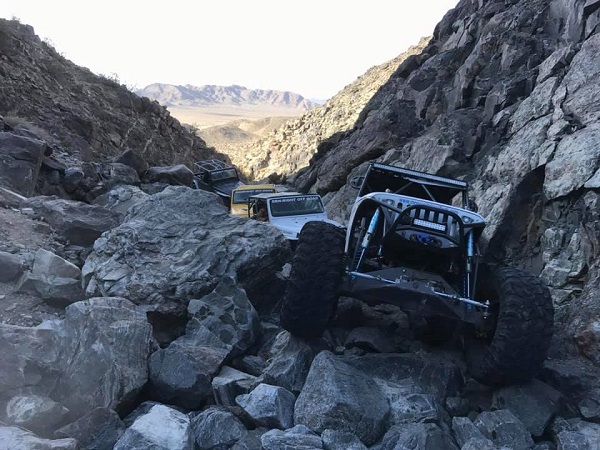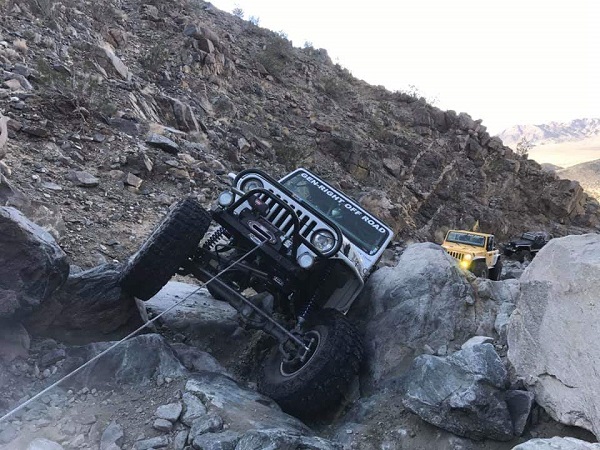You know the drill: when you’re part of a group trail run, the rule is to always keep the driver behind you in sight. If the vehicle in your rear-view mirror slows down, you slow down too, maintaining visual contact; if the driver stops, you stop. And if each driver is doing the right thing, the car ahead of you will also slow or stop, keeping you in the line of sight. All drivers pause until everyone is ready to go again. This way, no one is left behind to fend for themselves.
The off-road community has been using this look-out-for-the-one-behind system for years with much success. Ask any old time Jeeper, read any off-road blog, review the formal rules of any 4x4 organization. You’ll find this protocol with all of them. Why? Because it works.
When you’re following, the car ahead leads the way, and you benefit from watching. You get to see where the trail goes, and while everyone on the trail is ultimately responsible for making their own decisions, it’s a whole lot easier knowing the driver in front is picking the path. All you have to do is keep up. Confident in the trail leader’s guidance, you get to enjoy the drive a little more.

Another benefit that comes along with following is the advantage of watching your leader negotiate the obstacles. The up-front driver picks a line, determining both approach and strategy: over the rock with a slow and steady crawl? Or with forward momentum with a bit of a bump at just the right time? Because you see what works and what doesn’t, the advantage is yours. Knowing at least one way to overcome the challenge, you can proceed with more information than the previous driver.
And when someone is following you (remember, you’re keeping the car behind you in your mirror!), you give them the same advantage. They watch and learn as you show the way. You provide the same benefits that were just a few minutes ago given to you. It’s a share the wealth kinda thing. You keep those behind you on the right track, showing them where to turn, when to slow down, when to speed up, and how to outmaneuver whatever obstacles the trail sets in your way. It’s a tried and true system with results ranging from the convenient (no one gets lost) to the life-saving (no one gets lost).
But this way of traveling together isn’t reserved for only drivers of equal skill sets, or with comparably equipped vehicles. Nope. It doesn’t matter if you’ve got better equipment than the driver behind you, or if his capabilities or confidence don’t match your own; you look out and help out for him just the same. A driver that struggles to top the rock isn’t met with derision and certainly isn’t denied help. Instead, a winch line is thrown from the car ahead which now acts as both anchor, keeping the troubled car from tipping or rolling, and motive force, pulling the stuck driver to a place where he can once again move forward under his own power.

And granted, it’s not always without grumbling. Some forward drivers might grouse that the stuck car really should’ve had lockers, bigger tires, tougher drive-line, you name it. But no one is left on the trail with the admonition to “just try harder.” Help is always offered, no matter the cause of the difficulty, and the less knowledgeable/skilled/equipped driver has the opportunity to learn and improve for next time.
Off-roaders, with their commitment to look out for the driver behind, really get it right with this one simple philosophy.
All this makes me wonder what could happen if we off-roaders took this idea with us when we leave the trail and head back into “on-road” life. What if we looked at this way of thinking as a instructive for other parts of our lives? A way to better ourselves? A way to look out for others and to bring up all members of our communities?
Recognizing the help we’ve had from those folks who’ve paved the way for us is something, I think, we’re pretty familiar with. If we’re lucky, we’ve had mentors. Maybe it was a grade school teacher, a soccer coach, or a youth group leader. Or perhaps it was a boss, a friend, a neighbor, mom, dad, or some other family member. Most of us don’t go it alone and can remember the bright lodestars who’ve helped guide our way, especially when it came to figuring out the trouble spots. Having the guidance of trusted leaders, people who made the effort to look back at me to make sure I wasn’t falling too far behind and to offer a way through life, over obstacles, and toward success has been crucial in helping me get to where I am today.
But in our complicated and busy lives, it’s sometimes easy to forget to check our rear-view mirrors. I know it is for me. There have been many times when I could have reached back more than I did, stretched a little harder to ensure those “following” me benefitted from my path. I haven’t always paid enough attention to those coming up behind me.
So, in this new year, I’m going to do as my off-road friends have taught me: check my rear-view mirrors often! And when I do, if I see someone lagging behind, or struggling with a challenging spot in the road, I’ll stop, wait, and do what I can to help bring them along. I won’t ask why they didn’t do this or that to avoid a challenge; I’ll just to what I can to help them over it. I won’t chide them or insist they rely on their own bootstraps; I’ll offer support until they’re sure not to tip or roll over. If it works out on the trail, it ought to work in our neighborhoods, in our towns, and in our country, right? Maybe if we all check our mirrors a little more often, and are a bit more willing to stack some rocks now and then, all of us can make it to the top and nobody gets left behind. Happy New Year!